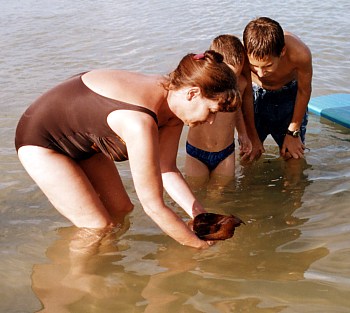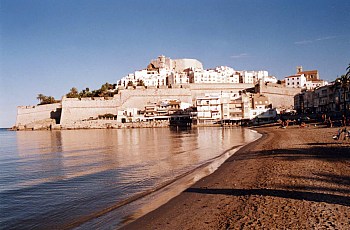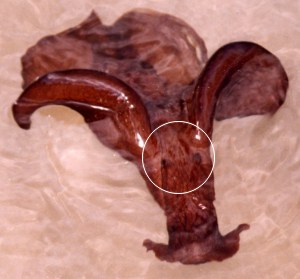Swimming Aplysia fasciata (2)
November 22, 2002
From: Job Tammens and Cisca Dekker


Dear Bill,
Thanks for your answer to our message. Here are two more pictures. The first attached foto shows my very brave girlfriend Cisca showing some local boys that it¹s completely harmless and therefore it¹s not necessary to hit them with everything available!!! It looks like they got the message. The second one is just to show you that seahares maybe appreciate a beautiful surrounding?!
Can you tell us what the two little black points in the neck are? I hope you enjoy the pictures and maybe next year we can send you some more.
Kind regards,
Job Tammens and Cisca Dekker.
job.tammens@12move.nl
Tammens, J. and Dekker, C., 2002 (Nov 22) Swimming Aplysia fasciata (2). [Message in] Sea Slug Forum. Australian Museum, Sydney. Available from http://www.seaslugforum.net/find/8477
Dear Job & Cisca,
Thanks for the photos. It certainly looks a beautiful spot to be a sea slug - except when small boys are on the prowl. Concerning the black spots you ask about. Sea Hares have two pairs of head tentacles - one pair, the oral tentacles, are clearly visible at the front of the head. The black spots, are the second pair, called rhinophores, which are set further back on the head. They usually are quite prominent and upright, but when out of water or constantly in and out of water, as they would be when swimming like this, they contract into small lumps. Have a look at the photos on the Aplysia parvula page to see the shape of the head more clearly. In those photos you will see a little black spot just in front of each rhinophore. That is the eye. It can't see images, only light and dark. Your Sea Hares are blissfully unaware of their beautiful surroundings - except for what they can feel with the oral tentacles and smell with their rhinophores.
Best wishes,
Bill Rudman
Related messages
-
Re: Aplysia brasiliana = Aplysia fasciata?
From: Bill West, February 13, 2009 -
Variation in egg mass color in Brazilian Aplysia fasciata
From: Vinicius Padula, July 10, 2008 -
Aplysia fasciata from Portugal
From: Valter Jacinto, July 2, 2008 -
Sea Hares washed up in Devon, UK
From: Rob Benzies, April 9, 2008 -
Swimming sea slug in France
From: Tim Twibell, October 4, 2007 -
Aplysia fasciata in western France
From: Michael Keys, September 3, 2007 -
Swimming Aplysia in Portugal
From: Gary Leman, August 20, 2007 -
Unidentified Sea Slug from Spain
From: David Gilbert, July 18, 2007 -
Have I been poisoned?
From: Pete Baker, July 17, 2007 -
Aplysia fasciata and A. punctata from Antibes
From: Dominique Horst, June 1, 2007 -
Aplysia fasciata from Greece
From: Hilary Cunliffe-Charlesworth, September 11, 2006 -
Aplysia fasciata? from the Canary Islands
From: Christian Kowalewski, August 21, 2006 -
Swimming Aplysia fasciata from Oeiras, Portugal
From: Ricardo Gomes Afonso, August 9, 2006 -
Are those 3 all Aplysia fasciata ?
From: Stephane Ores, June 9, 2006 -
Sea Hare from Cyprus
From: Helen Coombes, June 7, 2006 -
Aplysia fasciata? from Sao Paulo, Brazil
From: Armando de Luca Jr, March 16, 2006 -
Aplysia fasciata in Portugal
From: Mark Williams, January 28, 2006 -
A swimming Sea Hare from Brittany
From: Kate Bryant, December 5, 2005 -
Re: Aplysia fasciata in Spain
From: Job Tammens, October 14, 2005 -
Swimming Aplysia fasciata from Portugal
From: John Richardson, September 17, 2005 -
Swimming slug from France
From: Robyn Mason-Holt, August 26, 2005 -
Re: Swimming Slug from Greece
From: Graham Smith, July 25, 2005 -
Swimming Aplysia from Greece
From: K. Tzouvali, D. Pettas, April 20, 2005 -
Happy New Year
From: Elif Özgür, December 31, 2004 -
Swimming Sea Hare from Turkey
From: Elif Özgür, December 29, 2004 -
Aplysia fasciata? from Rio de Janeiro
From: Vinicius Padula Anderson, March 25, 2004 -
Aplysia brasiliana = Aplysia fasciata?
From: Bill Rudman, March 25, 2004 -
Sea Hare? swimming
From: A. Agnost, January 6, 2004 -
Andalucian sea creature
From: Peter Stanford, November 17, 2003 -
Re: Aplysia fasciata from Cape Verde Islands
From: Gérard Breton, September 24, 2003 -
Aplysia fasciata from Cape Verde Islands
From: Gérard Breton, August 20, 2003 -
Re: Aplysia from Mediterranean France
From: Marina Poddubetskaia, July 21, 2003 -
Aplysia from Mediterranean France
From: Marina Poddubetskaia , July 19, 2003 -
Aplysia fasciata: 2 colour forms from Senegal
From: Marina Poddubetskaia, June 27, 2003 -
Juvenile of Aplysia fasciata from Senegal
From: Marina Poddubetskaia, June 27, 2003 -
Aplysia fasciata from Israel
From: Bella Galil, May 6, 2003 -
Mottled Aplysia fasciata swimming
From: Joao Pedro Silva, May 3, 2003 -
Re: Aplysia fasciata in Spain
From: Job Tammens, November 27, 2002 -
Swimming Aplysia fasciata from Spain
From: Job Tammens , November 20, 2002 -
Aplysia fasciata swimming
From: Joao Pedro Tojal Silva, November 7, 2002 -
Re: Unknown egg mass from Turkey
From: Erwin Koehler, October 19, 2002 -
Re: Swimming Slug from Greece
From: George Sherman, August 6, 2002 -
Swimming slug? from Greece
From: George Sherman, July 13, 2002 -
'sea-bat' from southwestern France
From: Xavier, July 10, 2002 -
Aplysia fasciata from Portugal
From: João Pedro Silva, June 28, 2002 -
Aplysia fasciata from Portugal
From: Joao Pedro Silva, December 15, 2001 -
Mass Congregation of Aplysia fasciata
From: Hans Rothauscher, February 23, 2001
